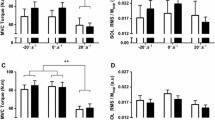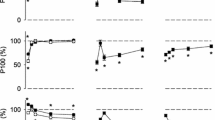Abstract
Neural, mechanical and muscle factors influence muscle force production. This study was, therefore, designed to compare possible differences in the function of the neuromuscular system among differently adapted subjects. A group of 11 power-trained athletes and 10 endurance-trained athletes volunteered as subjects for this study. Maximal voluntary isometric force and the rate of force production of the knee extensor and the plantar flexor muscles were measured. In addition, basic reflex function was measured in the two experimental conditions. The power athletes produced higher voluntary forces (P<0.01-0.001) with higher rates for force production (P<0.001) by both muscle groups measured. Unexpectedly, however, no differences were noticed in the electromyogram time curves between the groups. During reflex activity, the endurance group demonstrated higher sensitivity to the mechanical stimuli, i.e. the higher reflex amplitude caused a higher rate of reflex force development, and the reflex amplitude correlated with the averaged angular velocity. The differences in the isometric conditions could be explained by obviously different muscle fibre distribution, by different amounts of muscle mass, by possible differences in the force transmission from individual myofibrils to the skeletal muscle and by specificity of training. In addition, differences in nervous system structure and muscle spindle properties could explain the observed differences in reflex activity between the two groups.
Similar content being viewed by others
References
Andersen P, Henriksson J (1977) Training induced changes in the subgroups of human type II skeletal muscle fibers. Acta Physiol Scand 99:123–125
Bawa P, Binder MC, Ruenzel P, Henneman E (1984) Recruitment order of motoneurons in stretch reflexes is highly correlated with their axonal conduction velocity. J Neurophysiol 52:410–420
Borg TK, Caulfield JB (1980) Morphology of connective tissue in skeletal muscle. Tissue Cell 12:197–207
Botterman BR, Binder MC, Stuart DG (1978) Functional anatomy of the association between motor units and muscle receptors. Am Zool 18:135–152
Burke RE (1968) Firing patterns of gastrocnemius motor units in the decerebrate cat. J Physiol 196:631–654
Calancie B, Bawa P (1985) Firing patterns of human flexor carpi radialis motor units during the stretch reflex. J Neurophysiol 53:1179–1193
Cavanagh P, Komi PV (1979) Electromechanical delay in human skeletal muscle under concentric and eccentric contractions. Eur J Appl Physiol 45:159–163
Costill DL, Fink WJ, Pollock ML (1976) Muscle fiber composition and enzyme activities of elite distance runners. Med Sci Sports 8:96–100
Durnin J, Rahaman M (1967) The assessment of the amount of fat in the human body from measurements of skinfold thickness. Br J Nutr 21:681–689
Enoka RM (1988) Muscle strength and its development. New perspectives. Sports Med 6:146–168
Gollhofer A, Schmidtbleicher D (1989) Stretch reflex responses of the human m. triceps surae following mechanical stimulation. In: Gregor RJ, Zernicke RF, Whiting WC (eds) Congress Proceedings of XIIth International Congress of Biomechanics. UCLA, Los Angeles, USA, pp 219–220
Gollnick PD, Armstrong RB, Saltin B, Sauber IV CW, Sembrowich WL, Shephard RE (1973) Effect of training on enzyme activity and fiber composition of human skeletal muscle. J Appl Physiol 34:107–111
Green HJ, Thompson JA, Daub WD, Houston ME, Ranney DA (1979) Fiber composition, fiber size and enzyme activities in vastus lateralis of elite athletes involved in high intensity exercise. Eur J Appl Physiol 41:109–117
Häkkinen K, Komi PV (1983) Changes in neuromuscular performance in voluntary and reflex contraction during strength training in man. Int J Sports Med 4:282–288
Häkkinen K, Komi PV (1985a) Changes in electrical and mechanical behavior of leg extensor muscles during heavy resistance strength training. Scand J Sports Sci 7:55–65
Häkkinen K, Komi PV (1985b) Effect of explosive type strength training on electromyographic and force production characteristics of leg extensor muscles during concentric and various stretch-shortening cycle exercises. Scand J Sports Sci 7:65–76
Häkkinen K, Komi PV, Alen M (1985) Effect of explosive type strength training on isometric force- and relaxation time, electromyographic and muscle fibre characteristics of leg extensor muscles. Acta Physiol Scand 125:587–600
Häkkinen K, Pakarinen A, Kyröläinen H, Cheng S, Kim DH, Komi PV (1990) Neuromuscular adaptations and serum hormones in females during prolonged power training. Int J Sports Med 11:9–22
Howald H (1982) Training-induced morphological and functional changes in skeletal muscle. Int J Sports Med 3:1–12
Ikai M, Fukunaga T (1968) Calculation of muscle strength per unit cross-sectional area of human muscle by means of ultrasonic measurements. Eur J Appl Physiol 26:26–32
Jackson A, Pollock M (1985) Practical assessment of body composition. Phys Sportsmed 13:76–90
Jansson E, Sjödin B, Thorstensson A, Hultén B, Frith K (1978) Changes in muscle fibre type distribution in man after physical exercise. A sign of fibre type transformation? Acta Physiol Scand 104:235–237
Kamen G, Kroll W, Zigon ST (1981) Exercise effects upon reflex time components in weight lifters and distance runners. Med Sci Sports Exerc 13:198–204
Koceja DM, Kamen G (1988) Conditioned patellar tendon reflexes in sprint- and endurance-trained athletes. Med Sci Sports Exerc 20:172–177
Komi PV (1986) Training of muscle strength and power: interaction of neuromotoric, hypertrophic, and mechanical factors. Int J Sports Med 7:10–15
Komi PV, Karlsson J (1979) Physical performance, skeletal muscle enzyme activities, and fibre types in monozygous and dizygous twins of both sexes. Acta Physiol Scand [Suppl] 462:1–28
Komi PV, Viitasalo JHT, Havu M, Thorstensson A, Sjödin B, Karlsson J (1977) Skeletal muscle fibers and muscle enzyme activities in monozygous and dizygous twins of both sexes. Acta Physiol Scand 100:385–392
Komi PV, Karlsson J, Tesch P, Suominen H, Heikkinen E (1982) Effects of heavy resistance and explosive type strength training methods on mechanical, functional and metabolic aspects of performance. In: Komi PV (ed) Exercise and sport biology. Human Kinetics, Champaign, Ill., pp 90–102
MacDougall J, Ward G, Sale D, Sutton J (1977) Biochemical adaptation of human skeletal muscle to heavy resistance training and immobilization. J Appl Physiol 43:700–702
Moritani T, deVries H (1979) Neural factors versus hypertrophy in the time course of muscle strength gain. Am J Physiol Med 58:115–130
Rutherford OM, Jones DA (1986) The role of learning and coordination in strength training. Eur J Appl Physiol 55:100–105
Ryushi T, Häkkinen K, Kauhanen H, Komi PV (1988) Muscle fiber characteristics, muscle cross-sectional area and force production in strength athletes, physically active males and females. Scand J Sports Sci 10:7–15
Ryushi T, Fukunaga T, Yuasa K, Nakajima H (1990) The influence of motor unit composition and stature on fractioned patellar reflex times in untrained men, Eur J Appl Physiol 60:44–48
Sale D, MacDougall J, Alway S, Sutton J (1987) Voluntary strength and muscle characteristics in untrained men and women and male bodybuilders. J Appl Physiol 62:1786–1793
Saltin B, Henriksson J, Nygård E, Andersen P, Jansson E (1977) Fiber types and metabolic potentials of skeletal muscles in sedentary man and endurance runners. Ann NY Acad Sci 301:3–29
Thorstensson A, Larsson L, Tesch P, Karlsson J (1977) Muscle strength and fibre composition in athletes and sedentary men. Med Sci Sports 9:26–30
Viitasalo JT, Komi PV (1978) Force-time characteristics and fiber composition in human leg extensor muscles. Fur J Appl Physiol 40:7–15
Viitasalo JT, Komi PV (1981) Interrelationships between electromyographic, mechanical, muscle structure, and reflex time measurements in man. Acta Physiol Scand 111:97–103
Viitasalo JT, Saukkonen S, Komi PV (1980) Reproducibility of measurements of selected neuromuscular performance variables in man. Electromyogr Clin Neurophysiol 20:487–501
Author information
Authors and Affiliations
Rights and permissions
About this article
Cite this article
Kyröläinen, H., Komi, P.V. Neuromuscular performance of lower limbs during voluntary and reflex activity in power- and endurance-trained athletes. Europ. J. Appl. Physiol. 69, 233–239 (1994). https://doi.org/10.1007/BF01094794
Accepted:
Issue Date:
DOI: https://doi.org/10.1007/BF01094794




